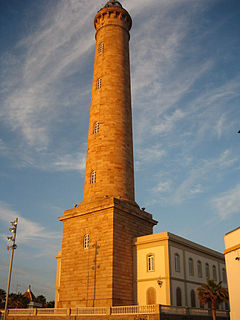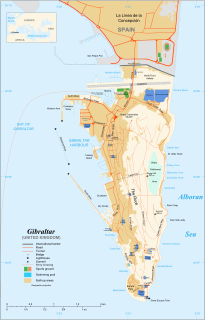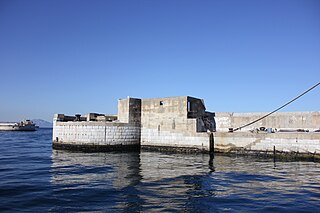
Because it was positioned near the busy shipping lanes of the mid-19th century, a lighthouse was built on Granite Island in 1868 by the U.S. Lighthouse Board and commissioned in 1869.

Founded in 2000 by Jim Weidner, K2JXW, the Amateur Radio Lighthouse Society (ARLHS) is devoted to maritime communications, amateur radio, lighthouses, and lightships. Its members travel to lighthouses around the world where they operate amateur radio equipment at or near the light. Collecting lighthouse QSLs is popular for some amateur radio operators. ARLHS is a membership organization with over 1665 members worldwide as of July 2009.

Chipiona Lighthouse, also known as Punta del Perro Light, is an active 19th-century lighthouse in Chipiona, in the province of Cádiz, Spain. At a height of 205 feet (62 m) it is the seventeenth tallest "traditional lighthouse" in the world, as well as the tallest in Spain. It is located on Punta del Perro, a projection of land into the Atlantic Ocean in the city of Chipiona, about 6 kilometres (3.7 mi) southwest of the Guadalquivir entrance, and serves as the landfall light for Seville.

Groote Kaap is a round steel lighthouse painted red with a white light casing on the North Sea coast in the dunes near Julianadorp by the sea, in the municipality of Schagen. The construction of the tower was completed in 1966. The tower was replaced in 1985.

The Europa Point Lighthouse, also referred to as the Trinity Lighthouse at Europa Point and the Victoria Tower or La Farola in Llanito, is a lighthouse at Europa Point, on the southeastern tip of the British Overseas Territory of Gibraltar, on the southern end of the Iberian Peninsula, at the entrance to the Mediterranean Sea.

The Gibraltar North Mole Lighthouse is one of several lighthouses in Gibraltar, the British Overseas Territory at the southern end of the Iberian Peninsula. Also referred to as the Gibraltar "D" Head Lighthouse, its cast-iron tower is painted black. The active lighthouse west of the Rock of Gibraltar is positioned on the Western Arm of the North Mole at Gibraltar Harbour, and is operated by the Gibraltar Port Authority.
The Gibraltar North Mole Elbow Lighthouse is one of several lighthouses in Gibraltar, a British Overseas Territory at the south end of the peninsula of Iberia. Also known as the Gibraltar "E" Head Lighthouse, its tower is painted grey. The active lighthouse is west of the Rock of Gibraltar and positioned at the elbow of the North Mole at Gibraltar Harbour. The lighthouse is operated by the Gibraltar Port Authority.
The Gibraltar Aerobeacon built in 1841 is one of several lighthouses in Gibraltar, the British Overseas Territory at the southern end of the Iberian Peninsula. It is also known as the Gibraltar Aviation Light and Gibraltar Aero Light. The active beacon is positioned atop the Rock of Gibraltar and is operated by the Government of Gibraltar.

The South Mole is a breakwater located in the southern section of Gibraltar Harbour, in the British Overseas Territory of Gibraltar, at the southern end of the Iberian Peninsula. Previously known as the New Mole and New Mole Extension, the South Mole, with the rest of harbour, is just north of the east entrance to the Strait of Gibraltar.

The Detached Mole is a breakwater located at the western aspect of the middle section of Gibraltar Harbour, in the British Overseas Territory of Gibraltar, at the southern end of the Iberian Peninsula. The Detached Mole, with the rest of harbour, is just north of the east entrance to the Strait of Gibraltar and was the site of the Detached Mole Battery. In addition to the role the breakwater plays in the defence of and access to the harbour, the Detached Mole provides berths for ships. The area adjacent to the mole is also a source of recreational and research opportunities, with dive sites at the wrecks of sunken ships.

The Gibraltar Detached Mole Lighthouse is one of several lighthouses in Gibraltar, a British Overseas Territory at the south end of the Iberian Peninsula. The lighthouse is positioned west of the Rock of Gibraltar, on the Detached Mole at the south entrance to Gibraltar Harbour.
The Gibraltar Detached Mole Lighthouse is one of several lighthouses in Gibraltar, a British Overseas Territory at the south end of the Iberian Peninsula. The lighthouse is positioned west of the Rock of Gibraltar, on the Detached Mole at the north entrance to Gibraltar Harbour.

The North Mole is a breakwater located in the northern section of Gibraltar Harbour, in the British Overseas Territory of Gibraltar, at the southern end of the Iberian Peninsula. The North Mole, with the rest of harbour, is just north of the east entrance to the Strait of Gibraltar. The breakwater was formerly known as the Commercial Mole, and is the site of the commercial port in the harbour. It was the consequence of a late nineteenth century plan by the British Admiralty to create a modern dockyard and large defensive harbour in Gibraltar.
The Marubi Palace Gardens Range Rear Lighthouse is located in the Marubi Palace Gardens in Stone Town, Zanzibar, Tanzania. The lighthouse is located to support ships trying to dock at the Stone Town harbor.
The Tumbatu Lighthouse is located on Tumbatu Island in Zanzibar, Tanzania. The lighthouse is one of the oldest lighthouses in the country and is a six-stage stone tower located on the northern tip of the island.

The Guia lighthouse is an active Portuguese lighthouse located at Cabo da Guia, about 2 km west of the centre of Cascais. It is an octagonal tower in white masonry with a red lantern that has a range of 18 nautical miles.

The Ponta do Altar Lighthouse is located in the Ferragudo parish of the Lagoa municipality in the Faro District of Portugal.













